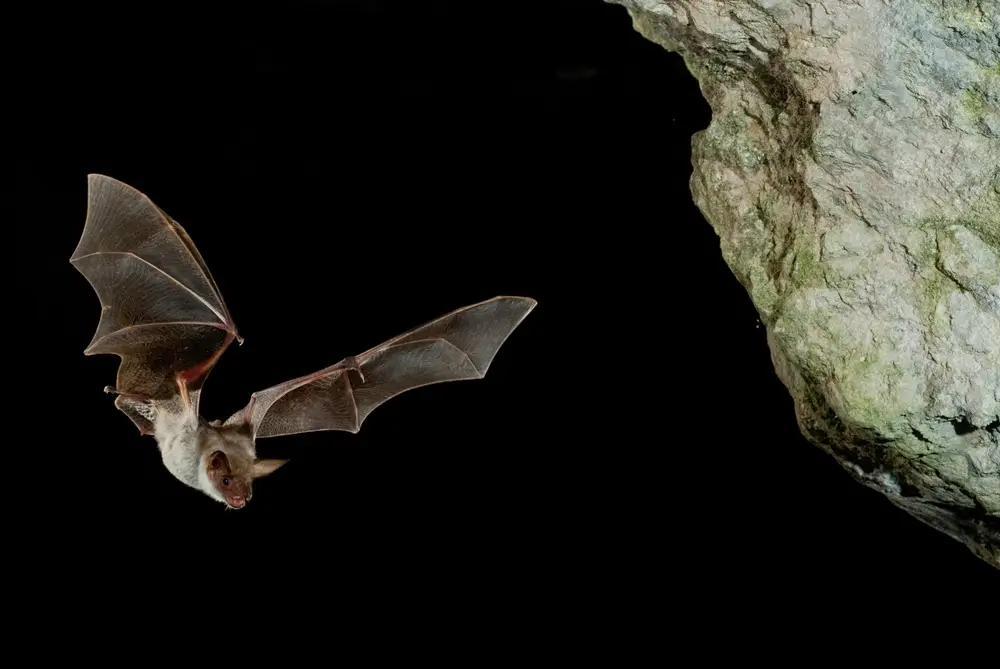Agriculture Threatens Bats. These Farmers Want to be Part of a Solution.
Bats help farms, but in general, farms don’t help them back. Some farmers are trying to change that with a more bat-friendly approach.
Agriculture Threatens Bats. These Farmers Want to be Part of a Solution.
Bats help farms, but in general, farms don’t help them back. Some farmers are trying to change that with a more bat-friendly approach.

by Shutterstock.
Bats are a captivating bunch, flying hundreds of miles, pinpointing prey with sonar and leading complex social lives. They’re also voracious predators of insects wreaking havoc on crops such as cotton, cocoa and rice.
By literally wiping out tons of pests every night, bats save US farmers an estimated $3.7 billion annually. Besides the bug carnage, bats also pollinate crops such as coconuts, agave, guava and bananas, disperse seeds and create fertilizer.
However, these little mammals are under attack—more than half of North American bats risk severe population declines over the next 15 years. And agriculture, which destroys foraging and roosting habitat, is one of the greatest threats to bats.
Yet farmers can be important allies for wildlife by using innovative practices to conserve bats. In turn, this mammalian air crew protects and pollinates their fields.
Pests and heirloom produce
“I know a lot of people are kind of freaked out by the bats but they are invaluable in sustainable agriculture—absolutely invaluable,” says Stephanie Miller, owner of Mystic Pine Farm in Virginia, which specializes in organic heirloom crops from the African diaspora.
Her farm is bustling with bat activity for several reasons.
“We don’t obviously use any chemicals because that’s also a main deterrent and that will definitely get rid of your bat population very quickly,” says Miller.
Besides directly poisoning bats, pesticides and insect-resistant crops reduce the abundance of their prey.

Miller also maintains oaks on her property to provide roosts for the bats and intentionally supplies food for her winged guests.
“I grow night-blooming plants that attract the bats and give them nectar and feed them,” says Miller. “Also, I grow species of native plants and what I would consider medicinal herbs that they also like to feed off of or attract the food that they eat—things like purple coneflower, yucca and sunflowers.”
Research backs these observations up: Lower-intensity practices such as agroforestry and organic farming support higher bat activity levels and diversity compared to more intensive agriculture.
Factors at the landscape level also come into play.
“You should always leave as much natural habitat as possible around your farms,” says Merlin Tuttle, a bat researcher and founder of Merlin Tuttle’s Bat Conservation. “Where pests do the worst damage is where you have huge monocultures, where for miles and miles you have nothing but corn or soybeans or wheat planted. And in those cases, bats and other natural predators can’t survive the off-season. After you harvest the corn or the wheat, there’s no pests out there to eat.”
In turn, Miller benefits from having bats around.
“I’m using nature, including the bats, to control my pest population,” says Miller. “And bats do a lot of work. They actually pollinate certain crops. They also eat pests that might be an issue and keep those populations under control.”
For instance, bats kill corn earworms, a major pest of popcorn and one of Miller’s main crops.

Pecan protection
While Miller exemplifies a bat-friendly farmer, she’s not alone. Through Merlin Tuttle’s Bat Conservation and Bat Conservation International, pecan farmers are learning how to cut down on pests by installing bat houses.
One example is John Worth Byrd, owner of a sustainable pecan farm in central Texas.
“We have three moth-born pests here, the walnut caterpillar, the pecan nut casebearer and the hickory shuckworm,” says Byrd. “But the bats, their primary food is moths. So, I thought, well that’s great. Some people in Georgia had done it, put bat houses into their pecan orchards. So, I started putting up bat houses.”
Byrd has five species of bats on his property. Some forage in wide open spaces away from their roosts, while others dine locally in the orchard canopy. While all the bats suppress pecan pests, the locavores kill the most.
Byrd uses a couple of strategies to help his bats. Besides putting up bat boxes, he doesn’t spray any pesticides on his property. In addition, if a tree dies in his orchard, he leaves it up.
“A lot of these bats roost in these old dead pecan trees…” says Byrd.
“The best bats were staying in these cavities, not as many numbers like the [Brazilian] free tails in my houses, but they were doing a lot. They were local feeders instead of feeding in the atmosphere.”
Unsurprisingly, all this pest-munching is valuable.
“If people could actually see what bats are doing, they’d be lined up to protect them,” says Tuttle. “It’s estimated by our Parks and Wildlife Department here in Texas that consumption of insect pests is saving Texas farmers approximately $1.4 billion annually.”
Aiding agaves
One of Mexico’s most iconic products has also jumped on the bat conservation bandwagon.
Through the Tequila Interchange Project, tequila and mezcal producers are growing bat-friendly agaves. These spiky plants are normally cloned, but letting some of them flower has several advantages. Night-blooming flowers provide nectar for bats, including an endangered species, the Mexican long-nosed bat. By feeding on the flowers, bats also pollinate them.
Commercial farming of blue agave, used for tequila, has eroded its genetic diversity and increased its susceptibility to disease. For instance, in the 1990s, a combination of bacteria and fungus spread through agave fields, and nearly 25 percent of the crop was abandoned.
This hasn’t gone unnoticed by agave farmers.
“They understand that something is happening,” says Irene Zapata Moran, a doctoral student at the University of Wyoming. “They see that there are more diseases in the crops. And people who have been in this industry all their life, they have told me they remember before that the plants used to be bigger.”

Bat pollination is seen as a solution, because as opposed to cloning genetically identical plants, sexual reproduction brings in new genes. This could also increase the plant’s ability to adapt to climate change.
However, allowing for natural pollination of agaves involves a direct financial hit for farmers.
Farmers normally cut the flower stalks on the agave to allow the sugar to be concentrated in the core. After harvesting, they use this core for tequila production.
“They’re completely rivals—you cannot have agaves in bloom and tequila from the same plot,” says Zapata Moran.
One solution could be for tequila producers to charge a premium price for bat-friendly products. Offsetting just a portion of their sunken costs could be an effective way to incentivize farmers who may not be motivated to give up some of their crops in the name of biodiversity.
The vast swaths of cropland and pasture blanketing the globe present a golden opportunity for bat conservation. And, with more than 18 percent of species listed as threatened globally, bats need all the help they can get. While sustainable practices require funding, cost-sharing programs, such as those from the USDA Natural Resources Conservation Service, can help farmers. Plus, the payoff is worth it—bats are an eco-friendly solution for many agricultural woes.
Follow us
This work is licensed under a Creative Commons Attribution-NoDerivatives 4.0 International License.
Want to republish a Modern Farmer story?
We are happy for Modern Farmer stories to be shared, and encourage you to republish our articles for your audience. When doing so, we ask that you follow these guidelines:
Please credit us and our writers
For the author byline, please use “Author Name, Modern Farmer.” At the top of our stories, if on the web, please include this text and link: “This story was originally published by Modern Farmer.”
Please make sure to include a link back to either our home page or the article URL.
At the bottom of the story, please include the following text:
“Modern Farmer is a nonprofit initiative dedicated to raising awareness and catalyzing action at the intersection of food, agriculture, and society. Read more at <link>Modern Farmer</link>.”
Use our widget
We’d like to be able to track our stories, so we ask that if you republish our content, you do so using our widget (located on the left hand side of the article). The HTML code has a built-in tracker that tells us the data and domain where the story was published, as well as view counts.
Check the image requirements
It’s your responsibility to confirm you're licensed to republish images in our articles. Some images, such as those from commercial providers, don't allow their images to be republished without permission or payment. Copyright terms are generally listed in the image caption and attribution. You are welcome to omit our images or substitute with your own. Charts and interactive graphics follow the same rules.
Don’t change too much. Or, ask us first.
Articles must be republished in their entirety. It’s okay to change references to time (“today” to “yesterday”) or location (“Iowa City, IA” to “here”). But please keep everything else the same.
If you feel strongly that a more material edit needs to be made, get in touch with us at [email protected]. We’re happy to discuss it with the original author, but we must have prior approval for changes before publication.
Special cases
Extracts. You may run the first few lines or paragraphs of the article and then say: “Read the full article at Modern Farmer” with a link back to the original article.
Quotes. You may quote authors provided you include a link back to the article URL.
Translations. These require writer approval. To inquire about translation of a Modern Farmer article, contact us at [email protected]
Signed consent / copyright release forms. These are not required, provided you are following these guidelines.
Print. Articles can be republished in print under these same rules, with the exception that you do not need to include the links.
Tag us
When sharing the story on social media, please tag us using the following: - Twitter (@ModFarm) - Facebook (@ModernFarmerMedia) - Instagram (@modfarm)
Use our content respectfully
Modern Farmer is a nonprofit and as such we share our content for free and in good faith in order to reach new audiences. Respectfully,
No selling ads against our stories. It’s okay to put our stories on pages with ads.
Don’t republish our material wholesale, or automatically; you need to select stories to be republished individually.
You have no rights to sell, license, syndicate, or otherwise represent yourself as the authorized owner of our material to any third parties. This means that you cannot actively publish or submit our work for syndication to third party platforms or apps like Apple News or Google News. We understand that publishers cannot fully control when certain third parties automatically summarize or crawl content from publishers’ own sites.
Keep in touch
We want to hear from you if you love Modern Farmer content, have a collaboration idea, or anything else to share. As a nonprofit outlet, we work in service of our community and are always open to comments, feedback, and ideas. Contact us at [email protected].by Ruscena Wiederholt, Modern Farmer
April 17, 2024
Modern Farmer Weekly
Solutions Hub
Innovations, ideas and inspiration. Actionable solutions for a resilient food system.
ExploreExplore other topics
Share With Us
We want to hear from Modern Farmer readers who have thoughtful commentary, actionable solutions, or helpful ideas to share.
SubmitNecessary cookies are absolutely essential for the website to function properly. This category only includes cookies that ensures basic functionalities and security features of the website. These cookies do not store any personal information.
Any cookies that may not be particularly necessary for the website to function and are used specifically to collect user personal data via analytics, ads, other embedded contents are termed as non-necessary cookies.